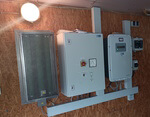News Release from Brüel & Kjær Vibro GmbH
Wind Industry Profile of
Virtual Site Survey for EDF
The wind turbine site survey is a very important function for retrofitting turbines with a condition monitoring system. The monitoring system specialist normally spends a couple of hours in the nacelle to determine where and how sensors are to be mounted on the drive train and tower. This task is absolutely critical for successful monitoring system implementation. In this article, we learn how the entire process has been carried out remotely during the Covid-19 pandemic and consider its likelihood as a solution for all future site surveys.
As downtime and service costs play an increasingly important role in the wind power sector, most wind turbines manufactured today are equipped with a factory installed condition monitoring system as standard. There are still many turbines out in the field, however, with no condition monitoring system at all. Wind turbine owners and operators for these turbines are therefore retrofitting condition monitoring systems to better manage their assets.
Brüel & Kjær Vibro (B&K Vibro) has substantial experience retrofitting a wide range of turbines and typically begins the entire retrofit process with a site visit. This is a necessary task, since there are usually five to eight sensors that have to be precisely installed on the drive train and tower, together with the monitoring system hardware, in order to achieve an effective monitoring solution.
Sensor installation
The most important objective of a site survey is to determine where the sensors are to be positioned and the type of mounting the sensors will be installed on. Accelerometers are the primary sensors used, since these are best for detecting faults in the rolling-element bearings and gearbox, and for monitoring tower vibration.
Bearings faults generally manifest in the lower vibration frequencies because of the slow rotational speeds of the shaft. The bearing fault signals also have very little vibrational energy and require sophisticated monitoring techniques to detect them. The sensors also have to be in close proximity to the monitored bearing in order to minimize sensor cross-talk. Some of the low-frequency bearing fault impacts can also excite high-frequency resonances of other components nearby, which can also be detected for monitoring purposes. These high-frequency signals can only travel only short distances through the casing because of the amplitude attenuation, therefore the sensor has to be close to the bearing in this case as well to detect these signals. This is similar for detecting gearbox faults, where the planet gears present the biggest challenge.
The sensor position with respect to the location of the potential failure modes to be detected is critical for effective condition monitoring. This applies also to the way the sensors are mounted to the casing, which can be by stud connection, which is best, or glue or magnetic mounting if there is difficult access. Therefore, the expertise of a monitoring specialist is needed during the survey to make these judgement calls, in order to ensure all relevant components are adequately monitored while taking into consideration signal attenuation.
The speed phase reference sensor installation is also important, as most of the fault detection measurements are synchronized to the shaft rotation for proper monitoring. This sensor is normally mounted on a custom-made bracket mounted above the shaft, which must be very rigid and robust and fit within the confines of the area.
Traditional site survey
The time needed for the site survey depends on many factors, but typically it can be 2-4 hours per turbine type. Much more time is needed, however, for both preparation of the visit as well as travel to site. Drawings and photos are studied ahead of time by B&K Vibro for a half day in preparation to the visit, to reduce the time spent onsite. The B&K Vibro technicians who will do the onsite survey have to be safety certified for the job together with their safety equipment.
Travel time to site can be several days, depending on the location, weather and even the political situation. On arrival, some time is needed to train the B&K Vibro technicians in safety measures before going up into the nacelle, and they are almost always accompanied by the owner/operator technicians or service provider during the entire time in the nacelle. As the B&K Vibro technician is doing most of the work, the wind farm technician is available to help but act mostly as observers.
After the site survey is done and all sensor locations and mountings have been identified together with the monitoring system bracket, the monitoring system specialist returns to Denmark to prepare a manual describing in detail how everything should be installed. This manual is then used by the owner/operator or service provider to physically install the sensors and monitoring unit.
Virtual site survey
During the Covid-19 pandemic in the spring of 2020, there were scheduled site survey jobs to complete but no possibility of onsite access. The remote monitoring and commissioning group at B&K Vibro came up with a solution; let the owner/operator technicians and service providers do the actual survey using live social media communications under the guidance of the monitoring specialists in Denmark. By sending photos and chat messages in real time, the entire site survey was conducted remotely, as a virtual site survey.
Warren Frith, EDF, UK, participated in the virtual site survey in May, 2020:
Have you ever done something similar, receiving instructions and communicating by a social media chat?
No, I have never been involved with anything like this before. The reason that we went down this route was to keep on track with the condition monitoring installation. Obviously due to travel restrictions at the height of the Covid-19 pandemic, B&K Vibro could not travel to site to carry out the surveys.
What went smoothly during the site survey, and what was challenging?
Each survey only took about two hours to complete. Myself and a colleague also had to take Covid-19 precautions, wearing appropriate PPE and keeping our social distance. We took instructions from B&K Vibro on which parts of the drive train they wanted to focus on. As B&K Vibro could observe via video chat, they could then determine the best locations to mount the sensors.
Are you willing to do it again?
I would be willing to do it again, as Covid-19 is going to be with us for some time. I can see this and other innovative ways of working becoming more useful in the future.
Conclusion
The virtual site survey proved to be a success despite the challenges. In the final analysis, there were enormous savings achieved in comparison to a normal site survey. For example, there were no travel expenses incurred and there were substantial savings in travel time. No safety training was required either. There was also better use made of the wind farm technician’s time, who was active in performing all the work and learning many things in the process.
After having completed two virtual site surveys, both the B&K Vibro project group and owner/operator technicians feel comfortable with this virtual site survey approach. There is still an issue with time zone differences for some jobs, and the qualifications of the technicians for other jobs may not be sufficient, but there are certainly a number of future jobs that could be performed in this way.
- Source:
- Brüel & Kjær Vibro
- Author:
- Press Office
- Link:
- www.bkvibro.com/...
- Keywords:
- Brüel & Kjær Vibro, site survey, survey, wind turbine, EDF, retrofit, condition monitoring, nacelle, manufacturer, site

























